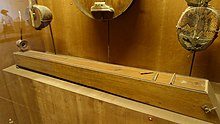Đàn bầu
This article needs additional citations for verification. (December 2023) |
water puppet show. Next to her was a man playing the đàn nguyệt . | |
| Other names | monochord, độc huyền cầm |
|---|---|
The đàn bầu (Vietnamese: [ɗàːn.ɓə̀w]; "gourd zither"; Chữ Nôm: 彈匏), also called độc huyền cầm (獨絃琴, "one-string zither"; the name is only used by the Jing ethnicity in China) is a Vietnamese stringed instrument, in the form of a monochord (one-string) zither.[1][2]
History

While the earliest written records of the đàn bầu date its origin to 1770, scholars estimate its age to be up to one thousand years older than that.
Construction

Originally, the đàn bầu was a

Playing

The đàn bầu technique appears relatively simple at first glance, but actually requires a great deal of precision. The fifth finger of the musician's right hand rests lightly on the string at one of seven commonly used nodes, while the thumb and index finger pluck the string using a long plectrum. The nodes are the notes of the first seven
Related instruments

The dúxiánqín (Sino-Vietnamese: độc huyền cầm; Chinese: 獨絃琴) is essentially the same instrument but given a Mandarin name, played by the Jing people in China, who are ethnically Vietnamese. The instrument was introduced to China when the Jing Islands off the coast of Dongxing, Guangxi were ceded to China by France.
The
References
- ^ Terry E. Miller, Sean Williams The Garland Encyclopedia of World Music: Southeast Asia: Volume 4 1998, reprinted The Garland handbook of Southeast Asian music 2008 Page 261 "The đàn bầu is played solo or to accompany folk songs, tales, and epics. It has had a remarkable history. Discriminated against at times, it has been an instrument of blind street beggars, yet it was also an instrument of choice at the Tran imperial court (1225-1400)."
- ^ Audrey Seah, Charissa M. Nair, Vietnam, Marshall Cavendish, 2004. p. 74.
- ^ "Age". discover-halong.com. Archived from the original on February 28, 2020. Retrieved July 1, 2018.
- ^ Dale Alan Olsen -Popular music of Vietnam: the politics of remembering 2008 Page 50 "In the summer of 2005 I specifically asked Hồng Nhung about my analysis of her style: D.O.: Are you influenced by ca trù, đàn bầu, the improvisatory instrumental style of water puppet theater, or other northern Vietnamese traditional music styles?"
- ^ Randy Raine-Reusch Play the World: The 101 World Instrument Primer Page 38 "Dan Bau - Vietnam The dan bau is a one-string zither from Vietnam that plays in harmonics. Dan in Vietnamese signifies an instrument, so often the instrument is just referred to as a bau. Some scholars believe that the dan bau is related to the Thai pin pia, while others believe that it is a uniquely Vietnamese instrument."
- ^ Vietnam minority music Vol. 2, #9: Muong "Dan Mang", retrieved 2020-01-05[dead YouTube link]
External links
- Đàn bầu page Archived 2017-06-26 at the Wayback Machine
- Vietnamese music page
